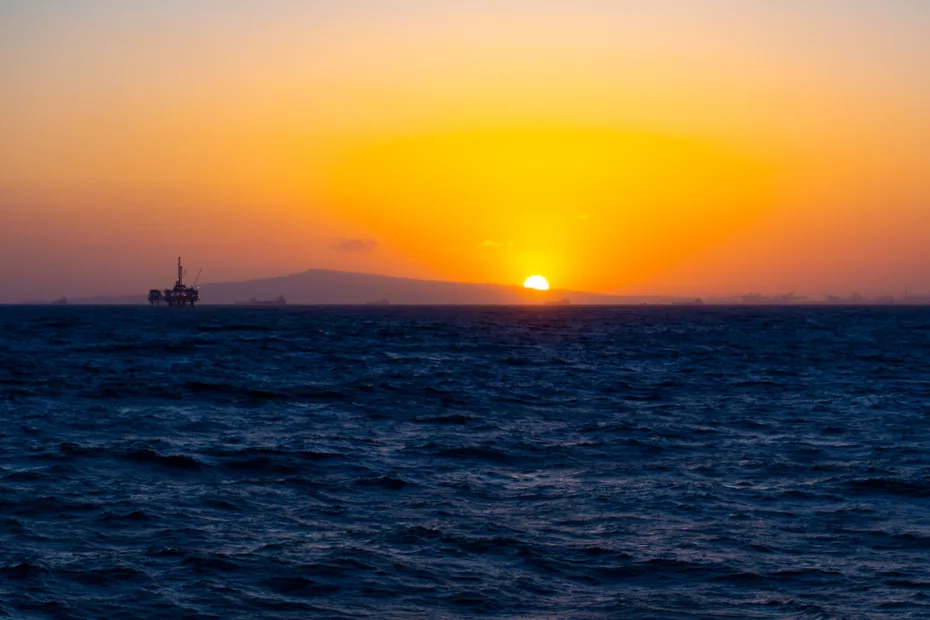Today, I’ve decided to share some tips on how publishing your travel stories. I’ll explain why I decided to share my experience, and how I went about it. To do this, I’m going to detail the whole workflow I put in place between the time I lived these moments in 2019, and today when you can discover, every week, the days I spent with Sarah in the West Coast.
Why publishing your travel stories?
That’s a good question! There are several reasons why you might choose to publish your travel stories.
- To remember: several years from now, I’ll be happy to reread everything I experienced in 2019 (I already have, by the way!).
- Sharing: at first, I started publishing my stories on a private blog for my family. It was a good way of sharing with them what I could experience and feel a few thousand miles away.
- Taking stock: I really enjoy taking time out, one or two years after the event, to analyze a past trip. It’s also an opportunity to look ahead to the next trip with greater serenity. You could call it feedback, if you like.
Other reasons for publishing one’s travel accounts may revolve around notoriety (being recognized for the trips you’ve made) or making money (difficult, in my opinion, unless you’re an excellent writer and photographer). Personally, I didn’t do it for these reasons, but it’s admissible too.
Now that we’ve answered the “why” question, let’s turn to the “how”.

Publishing your travel stories on a variety of formats
When it comes to publishing your travel stories, there are several options open to you. What are they? What are their advantages and disadvantages?
The book, to keep track for a long time
My first choice was to create a travel book. Its purpose was to tell the story of my adventure in chronological order. I would have written a chapter for each day and illustrated it with photos taken on the spot. This is more or less what I’m doing with the blog today.
Once the book has been published, it can be used to keep track of time. It’s marketable, available in bookshops and anyone can buy it for a price. You may earn a few euros, and you’ll be recognized not only for your travels, but also for your talents as a writer and photographer.
In my opinion, publishing your travel stories in book form is interesting for the reader. Okay, the medium isn’t free, but wouldn’t you rather read about a traveler’s adventures on paper, snuggled up on your sofa? Isn’t that more comfortable than a computer screen? Fortunately, the tablet has been invented… But all the same, I’m still a fan of paper books!
But be careful! Where you decide what you write on your blog, you’re not quite so free when it comes to a book published by a publisher… Publishing companies have an editorial line (more or less strict) and will have a say in your manuscript. They can be demanding and ask you to redraft your text many times… if you get past the manuscript submission stage.
Some (French) publishing companies
Here are a few of the French publishing houses I’ve identified that could enable anyone to publish their travel stories. Please note that I have not contacted them myself.
- Arthaud (Flammarion)
- Géorama Éditions
- Glénat
- Transboréal
- Robert Laffont
- Les Éditions du Mont-Blanc
- Les Éditions du Trésor
- Les Éditions Paulsen
- Les Éditions Phébus
- Payot-Rivages
A word of warning: some publishers will charge you to publish your stories. Beware, these are not publishing houses, and very often only “printers” who won’t even bother to distribute the finished works to bookshops! They even tend to pressure you to sign with them, telling you that the waiting list is long and that you only have 24 hours to sign. I experienced this with another manuscript that had nothing to do with travel.
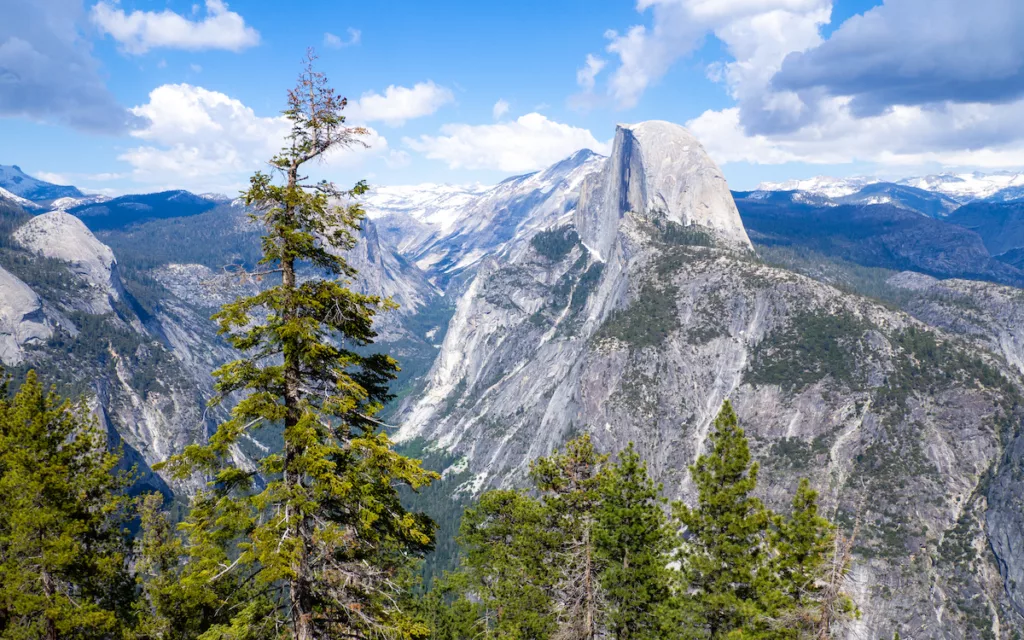
The blog, simple and effective!
Publishing your travel stories on your blog has one undeniable advantage: the freedom to write whatever you want. Indeed, no one will proofread and validate your manuscript if you publish it on your own blog. You can divide it up as you like, and it can even provide you with content over time. For example, it allows me to offer weekly content over several months!
Depending on the popularity of your blog, you’ll have more or fewer readers. This can be frustrating, given the time invested in writing. You also need to remain consistent with your own “editorial line”. If your blog is about Mustang, it can be inconsistent to publish your travel stories on it. That’s why I’ve been updating mine over the last few months.
If you choose this medium, I advise you to write texts long enough to be considered as chapters in their own right. Don’t forget to illustrate them with travel photos. It’s always nice to put a picture on what you’re reading!
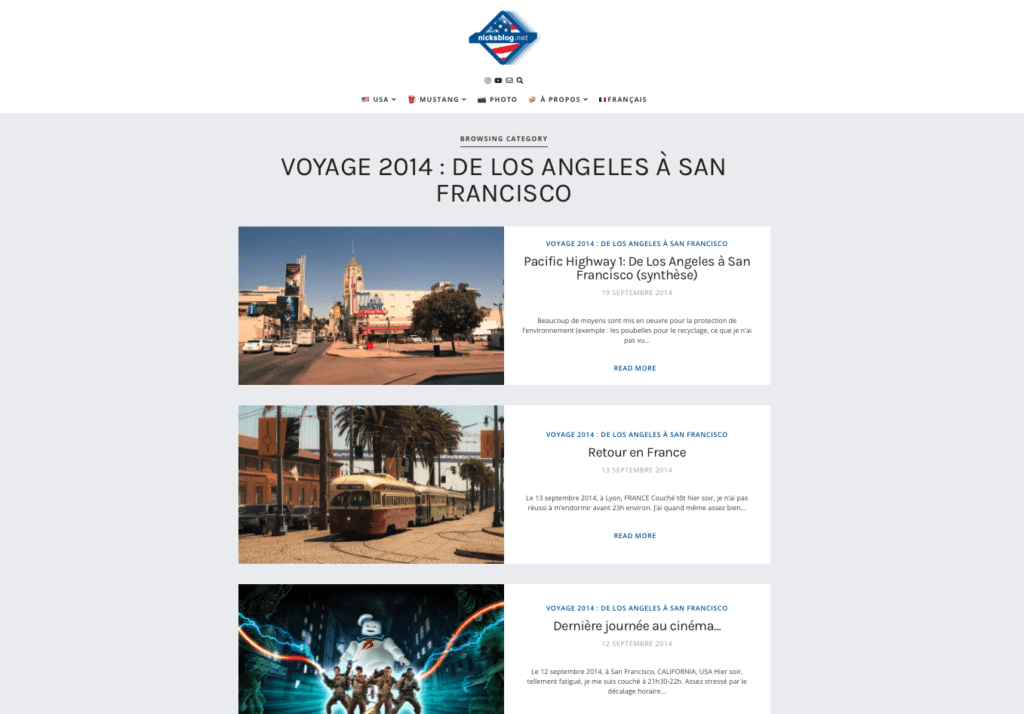
eBooks: increasingly popular
If you don’t have the energy to dine a publishing house and you don’t have a blog, what’s the alternative? Is it possible to publish your travel stories in eBook format? That’s a good question.
I’ve noticed that more and more people are interested. I’m not quite sure how much interest readers have in this format. Nevertheless, you can produce an eBook with very little effort (you generate a PDF from a Word file) or by spending days on it. I had done a bit a research into the latter option
For this, there are tools such as QuarkXPress (under licence) or Scribus (free). These can be complemented by Adobe Photoshop or Adobe Illustrator. A long time ago, I had the opportunity to use the former, and didn’t like it at all. More recently, for an unsuccessful project, I switched to Scribus. It’s an interesting program but, once again, if you want to produce something of quality, you’ll have to spend some time on it.
The podcast: why not?
At the beginning of the year, I was contacted by JC of the excellent Sunset BLD website to produce a series of podcasts about my trip to California. Using audio to tell the story of my trip had never occurred to me. And yet, the exercise was very interesting in more ways than one.
It’s an opportunity to synthesize what you’ve seen. JC had been clear: we couldn’t make a series with an episode for each day of the trip. It would have been too long and we’d have lost the audience. So I had to get to the heart of the matter, while recounting the anecdotes that had impressed me.
The audio format makes it easier to communicate sensations. It can be tedious to share a feeling in writing. It’s sometimes hard to find the words, but it’s always easier to convey an emotion by voice than by pen.
We take this opportunity to open new doors. Yes, when you’re a guest on a podcast, there’s often interaction. The host may ask you questions that lead you to reveal elements you may have buried deep in your memory…
As far as I’m concerned, I’ve been lucky enough to experiment with this format, and I’ve really enjoyed it. By the way, thanks JC for the opportunity! You can find the episodes on the trip’s main page, but it’s in French!
Well, that’s all well and good, but where do you start when you want to publish your travel stories? In the next section, I’ll take you through the workflow I used to achieve the results you’ve seen over the last few weeks.
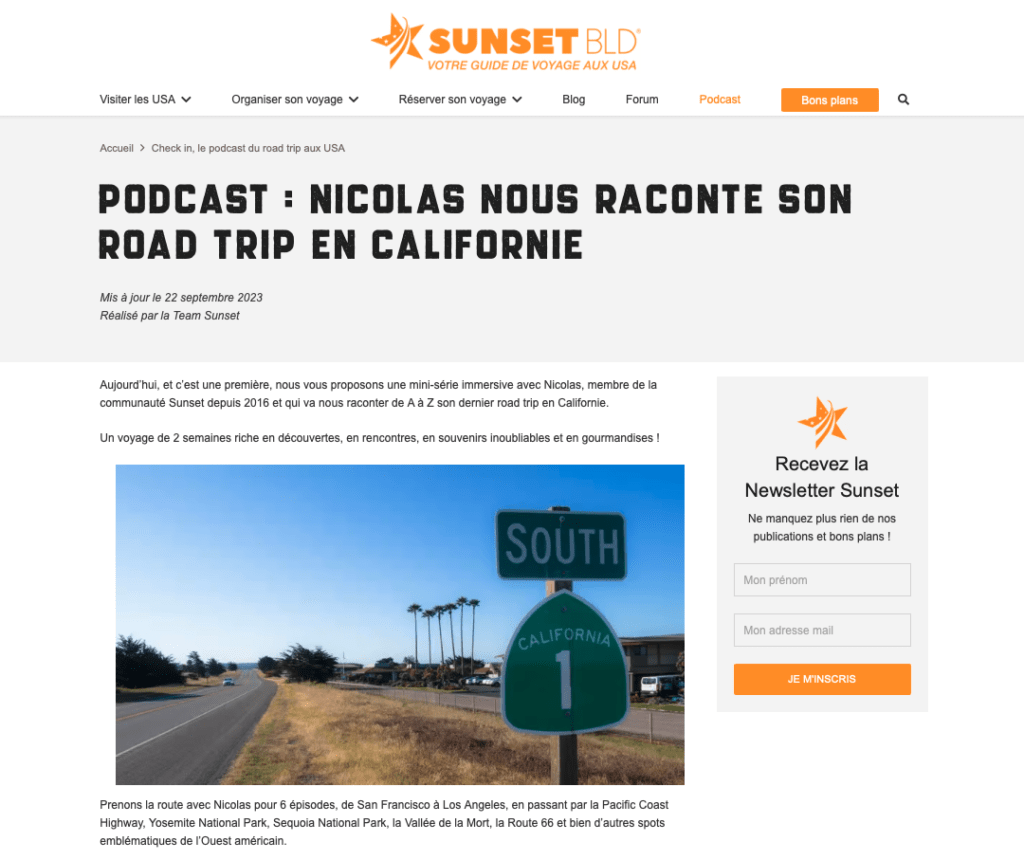
My workflow for publishing travel reports
Taking notes on the day, on the spot
The best time to start writing is, of course, on the spot. When you travel, you experience moments, sensations and emotions. You have everything you need to create quality content.
When I’m traveling, I always have a computer or tablet at my disposal. In the worst case, I have my phone. Whenever I have a moment during the day, I take notes on my phone’s “notes” application with what I’ve seen, what I’ve felt, what’s impressed me. In the evening, in my bedroom, I write sentences on my personal blog. The blog is for family only, so the audience is very small. At this stage, I avoid going into too much detail or incorporating information that requires Internet research. I’m traveling, often tired with hours of walking in my legs, and I need to rest.
I also take advantage of the evening to transfer the day’s photos to my computer. When I’m not too tired, I do a quick development using my favorite tool (Adobe Lightroom).
This first step takes me between forty minutes and an hour. That’s a long time in a day’s travel, but it’s indispensable for preserving accurate memories.
Reworking and deepening notes
Let’s face it, it can take a while to get interested in this part. As far as I’m concerned, I need at least one or two years to get from the trip to this writing stage. That’s a long time! Yes, I know. It’s a good opportunity to look back on your writing (done on the spot) to :
- Remember what you experienced with precision
- Give our manuscript a fresh look
During this stage, I keep the emotions (normally already written down). I also go a step further and find out more about the places I visited. For example, I’ll glean information about the history of a natural park or the habits of a population I’ve met.
A good way to delve deeper into the subject is to take photos of the explanatory panels during the trip. They’re full of interesting information that we simply ignore when we’re there. And yet, they are a goldmine for anyone interested in the history of the places we visit.
I try to write between 2,000 and 3,000 words for each day, depending on what I have to tell. Of course, you don’t have to write 3,000 words if you’ve spent the day at the moving theatre!
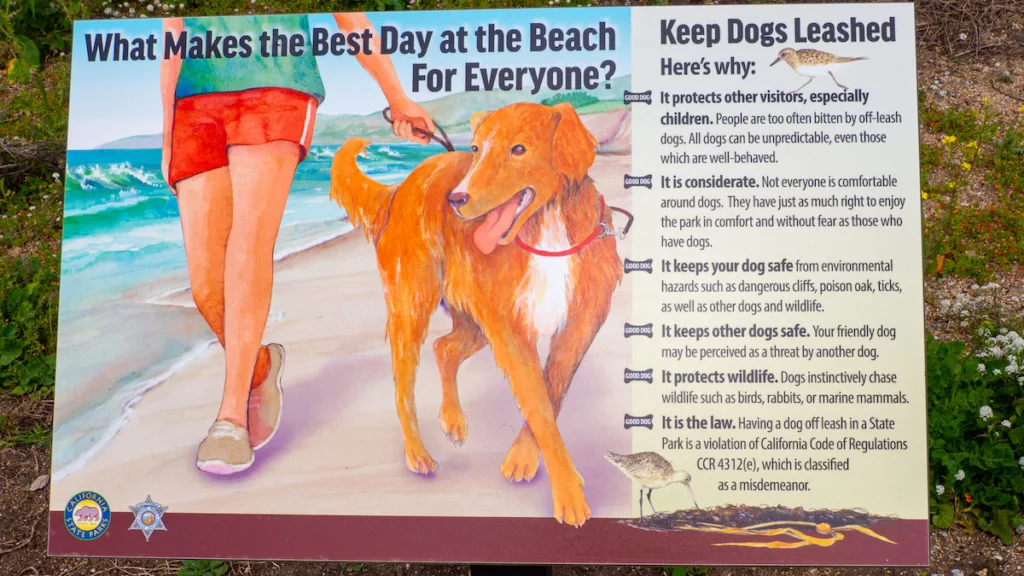
Translation of content before publication
Next comes the tedious task of translation. Of all the readers looking to publish their travel stories, only a few will be interested in this step. If you’re writing a book, you don’t need a translation. The same applies if your blog is your own language and aimed at your own language audience.
A few years ago, I chose to offer English as a secondary language on the blog. It allowed me to practice this language, which I appreciate very much, but that’s not the only reason. I interviewed several American Mustang owners and produced an English version for them to validate. This meant I didn’t have to make any extra effort to publish the article in the language of Shakespeare, and it opened me up to a wider audience. In short, I now publish the majority of my articles in both languages.
For the series of articles dedicated to my trip to the USA in 2019, I’m using translation tools. In particular, I’m using Deepl (sparingly). Some will be disappointed, but for this series, the translation work is titanic. So a little help is most welcome.
Review for SEO optimization
Once the article is written in French and English, it’s time to push it out onto the blog, WordPress for my part. Here, I’m using a plugin that I had uninstalled a long time ago and that I put back in place following a discussion with JC (Sunset BLD). It’s Yoast SEO. He points out a few things to watch out for and (strongly) encourages me to reduce the size of my sentences.
It’s not mandatory, but I’d like to think that readers will appreciate a text validated by Yoast… Maybe not! So, what do you think?
Photo integration
For several years now, I’ve been in the habit of shooting my photos in RAW format. I’ll come back to this format in another article. The blog is now about photography too!
All photos taken on location are stored in RAW format on my computer. In terms of organization, I created a folder for each day I was there. Before integrating my photos into WordPress, I carry out a post-processing stage using Adobe Lightroom.
I select my three, four or five favorite photos and then spread them out over my article. I try to insert them where it makes the most sense, but also to balance the article. It’s not always easy, but it’s generally satisfying!
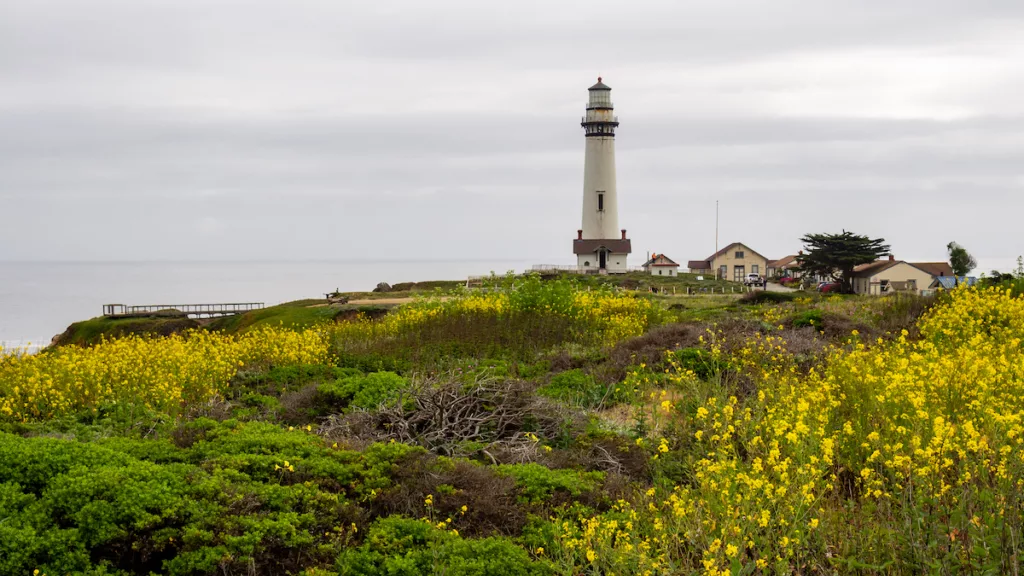
Publication at a pre-defined frequency
Finally, there’s just one step left: publishing your travel stories. Now that your work is ready, it’s time to publish it. I’ve chosen to set up a publication calendar. This allows me to prepare articles in advance and still have some content on hand, just in case. For the series of articles about my trip to the USA, it’s very practical. I know exactly when this or that article will come out and when the series will end. It’s up to me to prepare different content for the weeks that follow. And, best of all, with WordPress I can automatically schedule the publication of my content.
It’s also very practical for the reader. If you publish your content every Wednesday at 7:30 a.m., your readers get used to it. Joe will have breakfast while reading your last chapter next Wednesday, Samantha will discover the continuation of your adventures during the children’s afternoon nap, while Andrew will read your article on the metro… When they get up in the morning, they know they’ll get their weekly fix :).
Finally, publishing at a regular pace is also good for SEO. The robots at Google, Microsoft and others like to be able to count on regular content distribution. They know what to expect. No nasty surprises with you: you’re reliable!
And, let’s face it, humans are made of habit. If you get used to posting content every Wednesday and stick to it, you’ll get into the habit. This will help you to stick with it over the long term and do everything you can to keep up. So far, I’ve not been a good student, I admit!
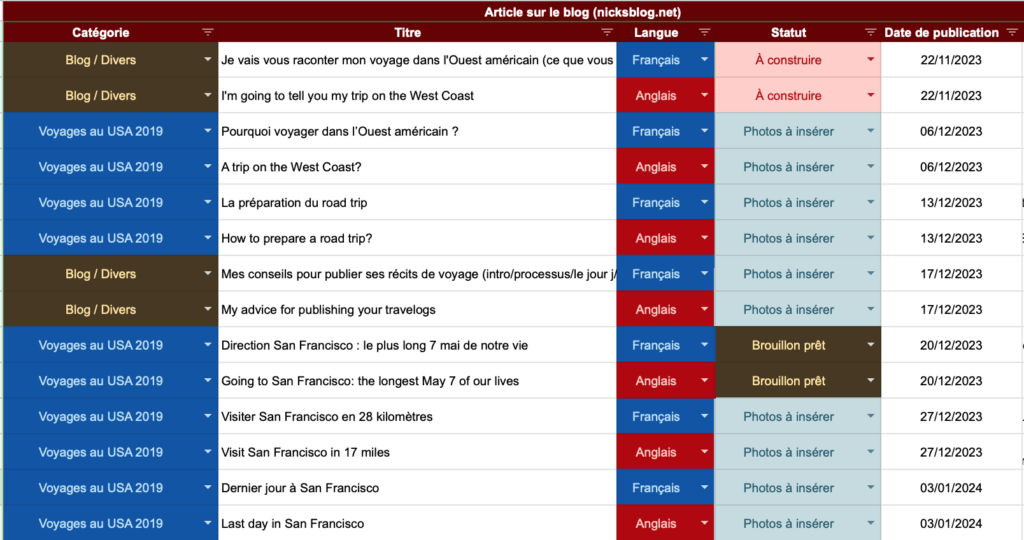
Conclusion
The time has come to conclude. For this last part, I’d like to suggest a few ideas for going further. I haven’t implemented them (yet!) but I think they’re interesting. If I had it to do over again, I’d use my phone to film a moment of the day (on camera, or not). I’d use the video format, or maybe just the audio. To be seen. I’d take the opportunity to describe how I’m feeling at the time, and maybe also give a brief description of the day I’m having. If I can do it every day, it would be a good complement to my (written) notes.
If you’ve made it this far, well done! I originally intended to keep this article to 800 words. I’m approaching 2,500 words. The subject is, I think, extremely rich and interesting.
I’ve tried to answer the following questions: Why publishing your travel stories? In what form? How do I go about it? I’ve tried to do this with complete transparency. The aim is simply to guide you if you want to move in this direction but don’t know where to start. I sincerely hope this article helps.


